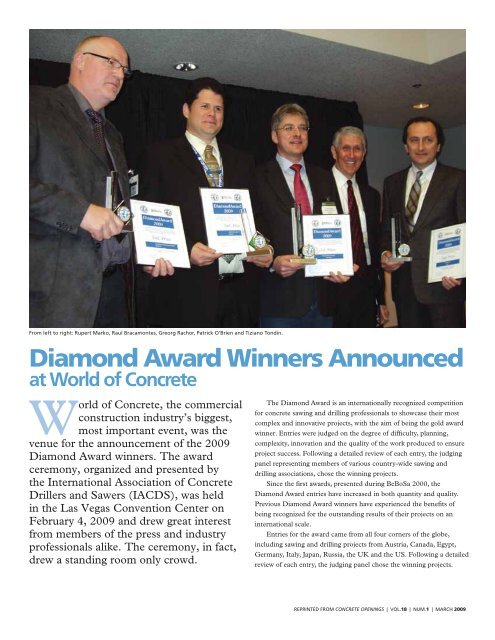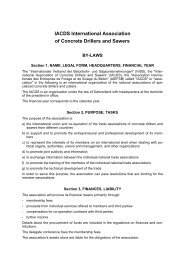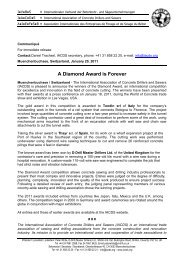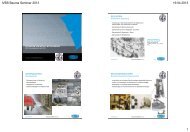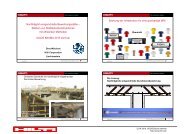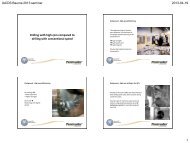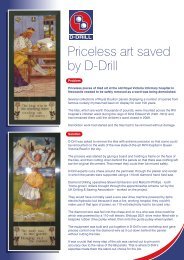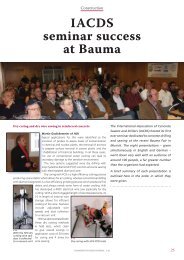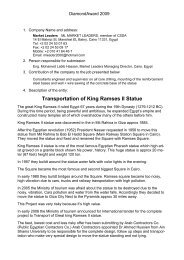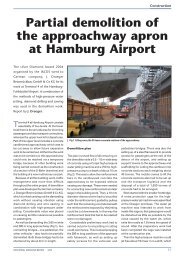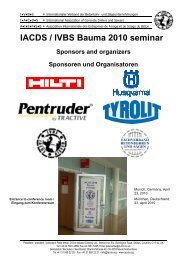Diamond Award Winners Announced - International Association of ...
Diamond Award Winners Announced - International Association of ...
Diamond Award Winners Announced - International Association of ...
Create successful ePaper yourself
Turn your PDF publications into a flip-book with our unique Google optimized e-Paper software.
From left to right: Rupert Marko, Raul Bracamontes, Greorg Rachor, Patrick O’Brien and Tiziano Tondin.<br />
<strong>Diamond</strong> <strong>Award</strong> <strong>Winners</strong> <strong>Announced</strong><br />
at World <strong>of</strong> Concrete<br />
World <strong>of</strong> Concrete, the commercial<br />
construction industry’s biggest,<br />
most important event, was the<br />
venue for the announcement <strong>of</strong> the 2009<br />
<strong>Diamond</strong> <strong>Award</strong> winners. The award<br />
ceremony, organized and presented by<br />
the <strong>International</strong> <strong>Association</strong> <strong>of</strong> Concrete<br />
Drillers and Sawers (IACDS), was held<br />
in the Las Vegas Convention Center on<br />
February 4, 2009 and drew great interest<br />
from members <strong>of</strong> the press and industry<br />
pr<strong>of</strong>essionals alike. The ceremony, in fact,<br />
drew a standing room only crowd.<br />
The <strong>Diamond</strong> <strong>Award</strong> is an internationally recognized competition<br />
for concrete sawing and drilling pr<strong>of</strong>essionals to showcase their most<br />
complex and innovative projects, with the aim <strong>of</strong> being the gold award<br />
winner. Entries were judged on the degree <strong>of</strong> difficulty, planning,<br />
complexity, innovation and the quality <strong>of</strong> the work produced to ensure<br />
project success. Following a detailed review <strong>of</strong> each entry, the judging<br />
panel representing members <strong>of</strong> various country-wide sawing and<br />
drilling associations, chose the winning projects.<br />
Since the first awards, presented during BeBoSa 2000, the<br />
<strong>Diamond</strong> <strong>Award</strong> entries have increased in both quantity and quality.<br />
Previous <strong>Diamond</strong> <strong>Award</strong> winners have experienced the benefits <strong>of</strong><br />
being recognized for the outstanding results <strong>of</strong> their projects on an<br />
international scale.<br />
Entries for the award came from all four corners <strong>of</strong> the globe,<br />
including sawing and drilling projects from Austria, Canada, Egypt,<br />
Germany, Italy, Japan, Russia, the UK and the US. Following a detailed<br />
review <strong>of</strong> each entry, the judging panel chose the winning projects.<br />
REPRINTED FROM CONCRETE OPENINGS | VOL.18 | NUM.1 | MARCH 2009
F E A T U R E<br />
Crucible repair project—ADRA.<br />
Bronze <strong>Award</strong><br />
The third place award was won jointly by CSDA members<br />
ADRA Tecnologia en Servicio <strong>of</strong> Mexico, and Germany’s BWW.<br />
Mittal Steel <strong>of</strong> Lazaro Cardenas, Mexico, one <strong>of</strong> the biggest<br />
steel producers in the world, suffered a major explosion in its<br />
furnace, damaging its crucible. Because <strong>of</strong> the damage sustained,<br />
Mittal Steel was losing approximately two billion dollars a day due<br />
to lack <strong>of</strong> production, and so needed its crucible to be rebuilt quickly<br />
and efficiently.<br />
The crucible, or melting pot, is a graphite container used to hold<br />
metal for melting in a furnace, and is required to withstand extreme<br />
temperatures. These crucibles are custom-made and are therefore<br />
extremely difficult to replace quickly.<br />
ADRA’s project was to repair the crucible by cutting 114 graphite<br />
blocks <strong>of</strong> different dimensions, using nitrogen gas instead <strong>of</strong> water,<br />
as a cooling agent. The reason for this was that if the graphite block<br />
absorbed water, this would create steam as the crucible heated up,<br />
creating pressure and cracking the furnace. The contractor also made<br />
new handling holes to elevate the pieces uniformly, coring 161 holes<br />
measuring 381 millimeters (15 inches) in diameter, 40 holes at 500<br />
millimeters (20 inches) in diameter and two holes at 127 millimeters<br />
(five inches) in diameter in the furnace. This came to a total area cut<br />
<strong>of</strong> 70 square meters.<br />
Raul Bracamontes <strong>of</strong> ADRA was pleased with the win, “I am very<br />
happy to be included as a winner along with these other great projects,<br />
and happy to be a CSDA member. ADRA worked hard to complete a<br />
difficult and demanding job, and this is a great reward for us.”<br />
BWW’s job in Koblenz, Germany, involved a large roll mill<br />
replacement project with severe time constraints. The job was to be<br />
completed within 120 hours, requiring non-stop operation. The job<br />
consisted <strong>of</strong> extensive alterations to the mill’s base to fit a new hot mill<br />
<strong>of</strong> a larger size. “It is a proud moment for myself and the company<br />
to win this award. The project was really hard, and the client was<br />
extremely pleased with the outcome. I would like to thank the IACDS<br />
Roll Mill replacement project—BWW.<br />
for the chance to receive the award here at World <strong>of</strong> Concrete,” said<br />
Rupert Marko, managing director <strong>of</strong> BWW.<br />
Various wall sawing and core drilling techniques, together with<br />
pressure removal and demolition methods, were used to remove<br />
concrete blocks and built-in anchors to create room for the new roll<br />
mill. The center <strong>of</strong> the existing base had a thickness <strong>of</strong> 4.5 meters<br />
(15 feet), where two recesses measuring 4.14 meters (13.6 feet)<br />
long, 2.1 meters (6.9 feet) wide and 2.25 meters (7.4 feet) deep<br />
were required to position the new roll mill in steel hulls with rolled<br />
concrete. Had BWW been allowed to carry out the work under<br />
standard shift hours, the process would have taken approximately<br />
two and a half weeks to complete.<br />
REPRINTED FROM CONCRETE OPENINGS | VOL.18 | NUM.1 | MARCH 2009
Loggia Palace foundation consolidation project—Tondin srl.<br />
Silver <strong>Award</strong><br />
Taking second place was another CSDA member, Tondin srl,<br />
for its work on a project to consolidate the foundation <strong>of</strong> the Loggia<br />
Palace in Brescia, Italy. Tondin was able to devise a high speed<br />
drilling system with micro bits to fit into confined spaces to restore<br />
the foundation. The project required the drilling <strong>of</strong> holes just 26<br />
millimeters (1 inch) in diameter, with a horizontal axis to perform the<br />
coring with a safe distance between the foundation and the ground<br />
below it. The holes created would be used to fill cavities in the terrain<br />
below where the original wooden piles had deteriorated. As work<br />
progressed, Tondin had to increase to a 32-millimeter (1.25-inch) bit<br />
because <strong>of</strong> the presence <strong>of</strong> rocks, stones and other erratic material in<br />
the soil. The core drills were custom-made to produce a rotation speed<br />
<strong>of</strong> approximately 1,600 rpm. Tiziano Tondin was thrilled about his<br />
successful entry, “I would have been happy to receive any award for<br />
the project, so to win the second place <strong>Diamond</strong> <strong>Award</strong> is fantastic. To<br />
be chosen above so many other outstanding submissions and have the<br />
project recognized is a great honor indeed.”<br />
Gold <strong>Award</strong><br />
In first place was Braun <strong>of</strong> Münster, Germany, for the company’s<br />
outstanding work dismantling a highly-contaminated steam dryer at<br />
a nuclear power plant. “I am honored to win this award, it is a great<br />
pleasure. The project specifications were very strict, with no room<br />
for mistakes. When the story was written and the entry submitted we<br />
were quite happy, as getting the story down on paper was a big task.<br />
Then to be invited to Las Vegas as a winner was an added bonus,” said<br />
Georg Rachor.<br />
The project involved putting the steam dryer in a steel formwork<br />
for radiation shielding, encasing it with concrete, and cutting it into<br />
pieces via remote control using diamond wire sawing techniques.<br />
Remote control wire sawing was a necessity to keep operators at a safe<br />
distance from the contaminated material, avoiding exposure to high<br />
levels <strong>of</strong> radiation. The cut parts were dismantled using a special wire<br />
saw design by Hilti AG, a WS 30 E type. Wire tensioning was effected<br />
through pneumatic cylinders with a pressure <strong>of</strong> up to 6 bars. The<br />
speed <strong>of</strong> the 10.5-millimeter (0.4-inch)-diameter wire could be<br />
REPRINTED FROM CONCRETE OPENINGS | VOL.18 | NUM.1 | MARCH 2009
F E A T U R E<br />
Steam dryer dismantling project—Braun.<br />
progressively adjusted between 0 and 35 meters per second. Once<br />
encased in concrete, the steam dryer was cut into 24 segments that<br />
were separated using hydraulic punches. These 24 segments were then<br />
individually removed and further cuts were performed to break the<br />
pieces down into smaller sizes for disposal. The cut pieces were packed<br />
in Type IV Konrad containers suitable for final disposal. In total,<br />
Braun removed approximately 184 square meters <strong>of</strong> steel and concrete<br />
while maintaining a high level <strong>of</strong> operator safety.<br />
The winners <strong>of</strong> 2009 <strong>Diamond</strong> <strong>Award</strong>s were presented custommade<br />
trophies and certificates by IACDS President Patrick O’Brien.<br />
The winners were notified in advance <strong>of</strong> the ceremony and arrived<br />
in Las Vegas via complimentary flights awarded by IACDS and<br />
complimentary hotel rooms by the World <strong>of</strong> Concrete. Georg Rachor,<br />
together with Tiziano Tondin, Rupert Marko and Raul Bracamontes<br />
were all on hand to accept their prestigious awards, and their<br />
companies now stand alongside the elite group <strong>of</strong> <strong>Diamond</strong> <strong>Award</strong><br />
winners that has been growing since the first ceremony back in 2000.<br />
IACDS is an international trade association <strong>of</strong> sawing and drilling<br />
associations from the concrete construction and renovation industry.<br />
Its mission is to provide an international union and cooperation <strong>of</strong><br />
trade associations to support and promote pr<strong>of</strong>essional development<br />
<strong>of</strong> pr<strong>of</strong>essional sawing and drilling contractors and their methods. This<br />
umbrella organization <strong>of</strong> sawing and drilling associations is composed<br />
<strong>of</strong> associations from Australia, Austria, Germany, Japan, Spain,<br />
Sweden, Switzerland, the UK and the US.<br />
Formed in 1995, the IACDS’s headquarters in Switzerland and<br />
holds meetings annually around the globe. For more information,<br />
contact IACDS at info@iacds.org or visit www.iacds.org.<br />
REVIEW AND COMMENT ON THIS ARTICLE AT WWW.CSDA.ORG/FORUM.cfm<br />
REPRINTED FROM CONCRETE OPENINGS | VOL.18 | NUM.1 | MARCH 2009


